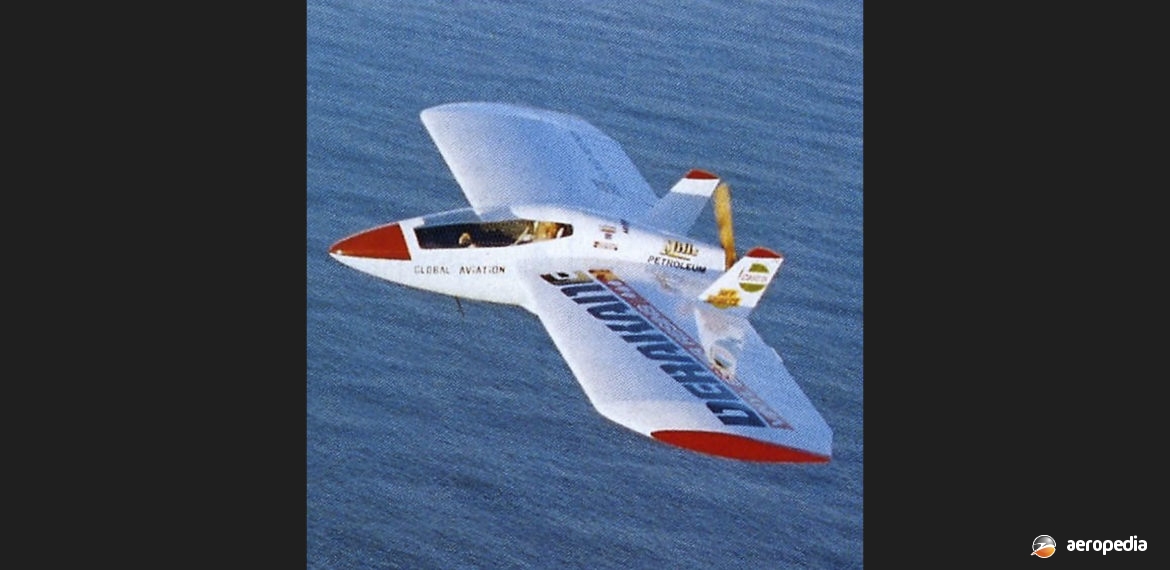Photograph:
The prototype Opal 10-0004 in flight (Winton Aviation)
Country of origin:
Australia
Description:
Single-seat high-performance sport aircraft
Power Plant:
One 30 kw (40 hp) Rotax 447 two-cylinder two-stroke in-line engine
Specifications:
- Wingspan: 6.6 m (21 ft 7 in)
- Length: 3.2 m (10 ft 6 in)
- Wing area: 10 m² (107.6 sq ft)
- Max speed: 280 km/h (174 mph)
- Initial rate of climb: 610 m/min (2,000 ft/min)
- Absolute range with 280 litres (62 Imp gals) of fuel: 5,600 km (3,480 miles)
- Empty weight: 110 kg (242.5 lb)
- Fuel weight: 117 kg (258 lb)
- Loaded weight: 300 kg (660 lb)
History:
In 1987 Australian light aircraft pilot, designer and builder, Eric Scott Winton (5/3/58 to 12/5/89), announced he would build an all-composite light aircraft which was essentially a flying wing with a span of 6.7 m (22 ft) and a weight of 99.7 kg (220 lb), a wing area of 10 m² (107.6 sq ft), powered by a Rotax engine which would provide 22 kw (30 hp) at 7,800 rpm. It was stated that it would be capable of setting new world records in just about every ultralight category and could fly from Ballina on the NSW north coast to Perth, WA on 182 litres (40 Imp gals) of fuel. The aircraft was designed and built to Civil Aviation Orders Part 95 Section 95.10 and had an ultimate strength of approximately 8G.
Also known as the Winton Facet Opal the aircraft was completed and underwent twelve months of intensive test flying and refinement before its attack on the world records. In that time more than 100 hours were flown and distances of up to 1,300 km (808 miles) were achieved non-stop. When first flown the Opal was fitted with a Rotax 532 engine, achieved a speed of 254 km/h (158 mph) and achieved a sustained rate of climb of 914 m/min (3,000 ft/min). In order to set records approval had to be received from the FAA, the international controlling body, and the Australian Civil Aviation Authority, which at that time limited this class of aircraft to 152 m (500 ft) above sea level.
On 5 March 1989, having flown from Tyagarah airfield to Evans Head, NSW, a record time to climb to a height of 3,000 m (9,943 ft) of 6 mins 46 seconds was set. On 16 March a time to height record to 6,000 m (19,685 ft) of 20 mins 30 seconds was set; and on 8 April 1989 an altitude record of 9,189.72 m (30,150 ft) for landplanes weighing less than 299 kg (660 lb) was set. Subsequently plans were put in train to attempt to set records in the speed and un-refuelled distance categories. Calculations projected a performance of an economic cruising speed of 252 km/h (156 mph) with a fuel burn of 6.9 kg (15.2 lb) per hour, an endurance of 17½ hours, with a range of 4,214 km (2,619 miles).
The Opal team received some sponsorship in relation to the record setting, including Mils Petroleum, Mobile One, Castrol, Global Aviation Support, Bert Flood Imports and Sky Sports. At one stage the Opal team was hopeful of gaining major sponsorship to fly across Australia in an attempt at the world record non-stop, non-refuelled distance for Microlight aircraft, the record at that time of 1,028.92 km (639.35 miles) being held by Thomas Pratt in the United States in a Mitchell Silver Eagle.
The Opal was a parallel chord flying wing, of rectangular plan-form, apart from raked tips. Construction followed the then high-tech composite techniques as used in the around-the-world non-stop Voyager, using Divinycell rigged PVC FOAM, ACI reinforcing materials and Dow Chemicals Derakane vinylester resins. The structure was light, strong and easy to build. It had an overload factor of seven, making it as strong as purpose designed aerobatic machines. The Rotax 447 engine was mounted at the rear of the fuselage pod driving a pusher propeller. The pilot was housed in a reclining position in a bullet-shaped pod, and there were two small vertical fins for directional stability. The undercarriage retracted, and the wing section was of the laminar flow type. Construction was of composite structure.
However, whilst flying the prototype aircraft near Newcastle, NSW on 12 May 1989 to visit a family gathering, the main spar broke. On this occasion Scott Winton flew in the Opal (registered 10-0004) from Tyagarah in northern NSW to Warnervale on the central coast. When it arrived at Lake Munmorah the aircraft was observed to circle Norahville and Lake Munmorah and then head for Doyalson when there was a structural failure, the aircraft breaking up. Investigations revealed the main carry-through spar had failed in overloading from an upward bending force. Scott Winton was fatally injured.
Father and son, Colin and Scott Winton, were prolific designers of light aircraft and their designs included the Brumby, Jackaroo, Sportsman, Grasshopper, Sapphire, and Opal referred to above. Scott Winton was also involved in the development of the Spitfire Aircraft Ultrabat.

